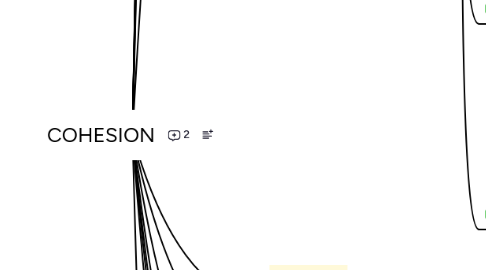
1. Rhetorical Cohesion
1.1. Menu
1.2. Parallelism
1.3. Characterize the meaning of a word in terms of its relation to other words.
1.3.1. The way on how sentences are connected each other (also context).
2. Tabloid newspaper article
3. Immediate physical environment
4. Question-Answer
4.1. It's incredible, ins´t it?
4.1.1. To highlight contrast
5. Genres
5.1. Epitaph
5.2. Set of instructions
6. Estate agent's blurb
6.1. To flag new information
7. Indefinite articles (eg. a)
8. Semantic roles
8.1. Agent
8.2. Theme
8.3. Instrument
8.4. Experiencer
8.5. Advert
8.6. Location
8.7. Source
8.8. Goal
9. To ommit elements
10. Grammatical Cohesion
10.1. Substitution
10.2. Ellipsis
10.3. Pronouns
10.3.1. Personal
10.3.1.1. Subject
10.3.1.2. Object
10.3.1.2.1. (Me - You - Us - Them - Him - Her - It)
10.3.2. Demonstrative
10.3.2.1. That
10.3.2.1.1. Has the effect of distancing the writer from the topic.
10.3.2.1.2. These and Those
10.3.2.2. This
10.3.2.2.1. Draws attention to new or important topic.
10.3.2.2.2. Can refer both back and forward in a text
10.3.3. Possesive
10.3.3.1. Mine - Yours - His - Hers - Its - Ours - Theirs
10.3.3.2. Back reference only.
10.3.4. Reflexive
10.3.4.1. Myself - Yourself - Ourselves - Themselves - Himself - Herself - Itself.
10.4. E.g: "A boy was walking..."
10.5. Reference outside the text.
10.6. Reference
10.6.1. Articles
10.6.1.1. "My book".
10.6.1.2. Definite articles (eg. the)
10.6.1.2.1. Make connections (back, forward, outside the text)
10.6.1.2.2. We know the schema.
10.6.1.2.3. A previous mention of a noun
10.6.1.2.4. Use in superlatives, defining relative clauses
10.6.1.3. Indefinite article a/an
10.6.1.3.1. to refer to something for the first time
10.6.1.4. It has a mention before or after in the text.
10.6.1.5. Zero
10.6.1.5.1. in plural or uncountable nouns
10.6.1.5.2. General things
10.6.2. Possessive Adjetives
10.6.3. It may be
10.6.3.1. Exophoric
10.6.3.1.1. A lot can be left unsaid
10.6.4. Other referents
10.6.4.1. Text
10.6.4.1.1. Visual information
10.7. Conjuncts (linkers)
10.7.1. Categories (logical relation)
10.7.1.1. Additive
10.7.1.1.1. Eg: also, too, as well, moreover, what's more, in addition, for example, likewise, similarly
10.7.1.2. Adversative
10.7.1.2.1. Eg: but, though, however, on the other hand, in fact, alternatively, in spite of that
10.7.1.2.2. Demonstrative reference (Deictics)
10.7.1.3. Causal
10.7.1.3.1. Eg: this is why, so, therefore, as a result
10.7.1.4. Shared cultural knowledge (shema, or sth unique like "sun", "moon").
10.7.1.5. Temporal
10.7.1.5.1. Eg: next, then, finally, in the meantime, ever since, first, to begin with, lastly
10.7.2. Eg: what's even better
10.7.3. Endophoric
10.7.3.1. Anaphoric
10.7.3.1.1. Back-reference
10.7.3.2. Cataphoric
10.7.3.2.1. to anticipate the referent
10.7.4. Syntactic constraints
10.7.5. Stylistic
10.7.5.1. Very formal
10.7.5.1.1. Eg: notwithstanding, whereupon
10.7.5.2. Relatively informal
10.7.5.2.1. Eg: still, what's more
10.7.5.3. Spoken language
10.8. Comparatives
10.8.1. Quantity and number
10.8.1.1. Eg: more, fewer, less, another
10.8.2. Possible to omit the reference point
10.8.3. -est
10.8.3.1. Eg: talles, nicest, healthiest
10.8.4. -er
10.8.4.1. Spoken
10.8.4.2. Eg: taller, nicer, healthier
10.9. Verbs
10.9.1. Tense
10.9.1.1. The effect it cause/why?
10.9.1.2. Past
10.9.1.2.1. Genre
10.9.1.2.2. To look elsewhere for information, with a particular aim in mind - to compare
10.9.1.3. Present
10.9.1.3.1. Genre
10.9.2. Voice
10.9.2.1. Passive
10.9.2.1.1. A veneer of neutrality
10.9.2.1.2. To focus on the process itself
10.9.2.2. Active
10.10. Theme
10.10.1. Position: first part of a sentence
10.10.2. Cf: Focus
11. Genre
12. Universal truths
13. Information text
13.1. Different semantic fields are woven together to foreground an idea.
13.2. The nature of things
13.3. How thing are
14. Institutional procedures
14.1. Legal documents
14.2. Scientific report
15. Position: at the end of a sentence
16. To depersonalise a text
17. If a verb takes an object as well as a subjetc, it can be changed from active to passive.
17.1. Eg: She sold the cart
17.2. Eg: He kept the pictures
17.2.1. The subject matter of the sentence
18. Lexical Cohesion
18.1. The effect sb wants to create/structure.
18.2. Homophones
18.2.1. Same pronunciation, different meaning.
18.2.2. Eg
18.2.2.1. bear/bare
18.2.2.2. meet/meat
18.2.2.3. flour/flower
18.2.2.4. pail/pale
18.2.2.5. right/write
18.2.2.6. sew/so
18.2.2.7. to/two/too
18.3. Word families
18.3.1. exit, transit, transition
18.4. Lexical Relations
18.4.1. Synonymys
18.4.1.1. A word that has many meanings.
18.4.1.2. Words with almost the same meaning
18.4.2. Near-synonyms
18.4.2.1. Saving, investment
18.4.3. Antonymys
18.4.3.1. Gradable
18.4.3.1.1. opposite meaning (hot-cold)
18.4.3.2. Non gradable
18.4.3.2.1. Conversives
18.4.3.3. Reversives
18.4.3.3.1. "the opposite of..." - "do the reverse of..."
18.4.4. Hyponymy
18.4.4.1. 'a Kind of relationship' (reliable).
18.4.4.2. Superordinate
18.4.4.3. Co-hyponyms
18.4.5. Prototype
18.4.5.1. Resemblance (Subjective).
18.4.6. Homonyms
18.4.6.1. (Unrelated) One word (written/spoken) has two or more meanings.
18.4.6.2. Eg
18.4.6.2.1. bat
18.4.6.2.2. mole
18.4.6.2.3. pen
18.4.7. run
18.4.7.1. person does
18.4.7.2. sole
18.4.7.2.1. single
18.4.7.2.2. part of foot or shoe
18.4.7.3. water does
18.4.7.4. colors do
18.4.8. Polysemy
18.4.8.1. Two or more words with the same form and related meanings
18.4.8.2. race
18.4.8.2.1. contest of speed
18.4.8.2.2. ethnic group
18.4.8.3. Eg
18.4.8.3.1. foot
18.4.8.3.2. mouth
18.4.9. Word Play
18.4.9.1. Humor
18.4.10. Metonomy
18.4.10.1. Actions and events
18.4.10.1.1. Eg: situation, process, way.
18.4.10.2. Relation of contiguity.
18.4.10.2.1. Container - Content
18.4.10.2.2. Whole - Part
18.4.10.2.3. Representative - Symbol
18.5. Lexical Devices
18.5.1. Direct repetition
18.5.2. Nominalization
18.5.2.1. Ideas and toughts
18.5.2.1.1. Eg: idea, theory, viewpoint.
18.5.3. Semantic field, lexical chains, lists.
18.5.4. Collocation
18.5.4.1. Ocurring together
18.5.4.1.1. E.g: I don't know what to do
18.5.5. Foregrounding
18.5.5.1. Draw attention to something and make the reader view it in a certain way.
18.5.6. Level of formality
18.5.6.1. Varies according to
18.5.6.1.1. Group of writers / members of an occupational group
18.5.6.1.2. The audience
18.5.6.1.3. Writer-reader relationship
18.5.6.1.4. Purpose
18.5.6.2. What has been said or written
18.5.6.2.1. Eg: explanation, criticism, proposal, suggestion, etc.
18.5.6.3. At the level of vocabulary

